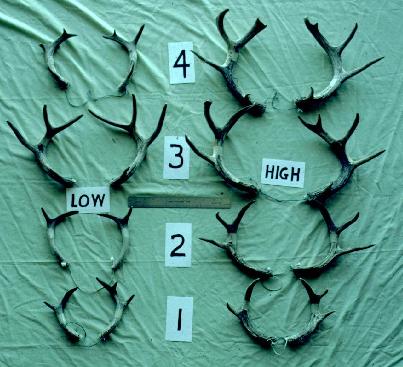White-tailed Deer
Role of Nutrition in Antler Development
In one of the early studies conducted at the Kerr Wildlife Management Area, TPWD biologists collected a group of buck fawns from throughout the state of Texas. They bottle raised these fawns, weaned them in September, and placed each fawn in an individual pen. They studied the fawns in the pens for 4 years. One group was fed a low protein diet of 8%. The other group was fed a high protein diet of 16%. research facility).

This is a slide of antlers from 2 deer in the study, and illustrates what we saw. The deer on the left was fed a low protein diet; the deer on the right a 16% protein diet. Of all the deer fed a low protein diet, not one turned out to be a spike. This was not expected. When you feed them that poorly, you expect to grow some spikes. We became suspicious of our feed and had it reanalyzed. We found out the feed company had done us a favor. They sent us 10.5% protein feed instead of 8%. The Low (left) side #1 is the first set of antlers produced by the deer that was fed a 10.5% protein diet, 4 pounds a day. His second set, #2, was produced on a diet of 8% protein, 4 pounds a day. The third set, #3, was grown with 8% protein, 5 pounds a day. The fourth set resulted from a diet of 8% protein, 4 pounds a day. The deer on the right was fed a 16% protein diet, 4 pounds a day for the 1st, 2nd, and 4th sets of antlers. The 3rd set was grown with 16% protein, 5 pounds a day. The take home message is "You feed them good, you grow them big. If you feed them bad, you grow them small." Nutrition does make a difference in antler growth.